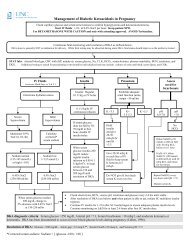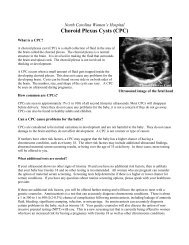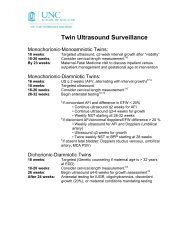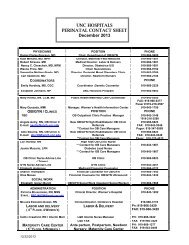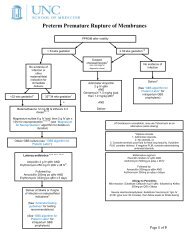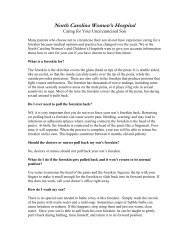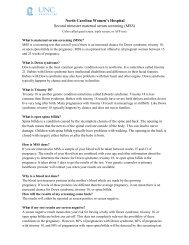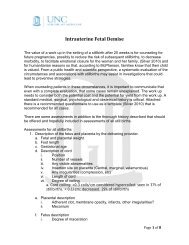Preventing Preterm Birth: - UNC Center for Maternal & Infant Health
Preventing Preterm Birth: - UNC Center for Maternal & Infant Health
Preventing Preterm Birth: - UNC Center for Maternal & Infant Health
Create successful ePaper yourself
Turn your PDF publications into a flip-book with our unique Google optimized e-Paper software.
How Do You Store 17P?<br />
The shelf life of 17P is 6 months. The medication can be kept at room temperature and does not need<br />
refrigeration. For best results, 17P should be kept in a dry place away from direct heat and sunlight. If the<br />
medication looks cloudy it may have been stored <strong>for</strong> too long.<br />
How Can 17P Be Billed and How Do I Order 17P <strong>for</strong> My Patient?<br />
In North Carolina many health insurance providers, including Medicaid, cover 17P. Other states may<br />
have different funding options. Additionally, a pool of funds is available to help provide some coverage <strong>for</strong><br />
mothers without insurance. For in<strong>for</strong>mation on billing codes, 17P pharmacies, and to order the drug,<br />
please visit www.mombaby.org.<br />
What Else Can Patients Do to Prevent a <strong>Preterm</strong> <strong>Birth</strong>?<br />
The use of 17P does not guarantee that the pregnancy will be carried to<br />
term. There<strong>for</strong>e, it is important that patients be counseled at every visit<br />
about how to reduce the risk of preterm birth and ways to recognize the<br />
signs of preterm labor. Patient in<strong>for</strong>mation sheets on 17P and preterm birth<br />
are available on the web. Visit www.mombaby.org to download and print<br />
these fact sheets <strong>for</strong> patients. A short video is also available <strong>for</strong> viewing.<br />
<strong>Preventing</strong> <strong>Preterm</strong> <strong>Birth</strong>:<br />
Progesterone Treatment (17P)<br />
<strong>Health</strong> Care<br />
Provider<br />
In<strong>for</strong>mation<br />
If a patient goes into preterm labor, other measures will be needed to delay<br />
birth. These might include tocolytics to stop contractions and steroids to<br />
help develop the baby’s lungs. In some circumstances, bed rest may be<br />
recommended. If a woman is going to deliver early, it is best that she give<br />
birth in a facility that has a high-level intensive care nursery.<br />
Questions?<br />
Please visit www.mombaby.org to locate in<strong>for</strong>mation about 17P. Click on <strong>Health</strong> Care Professionals,<br />
then Progesterone.<br />
Published by Noirbaby, Inc., <strong>for</strong><br />
the 17P Project, the NC<br />
Division of Public <strong>Health</strong>, and<br />
the <strong>UNC</strong> <strong>Center</strong> <strong>for</strong> <strong>Maternal</strong><br />
and <strong>Infant</strong> <strong>Health</strong>.<br />
www.mombaby.org<br />
4,000 copies of this public document were printed at a total cost of $1,680.00 or $.42 each. (7/07)
Has your patient had a premature baby? Is she pregnant again? If so, you need<br />
to know that there is a new type of treatment that may help prevent another<br />
preterm birth.<br />
What Are the Potential Side Effects of 17P?<br />
Side effects are very rare. If side effects do occur, they commonly include soreness, swelling, itching, or<br />
bruising at the site of the injection.<br />
What Is 17P?<br />
The progesterone treatment known as 17 alpha-hydroxyprogesterone<br />
caproate (17P) has been shown to reduce the risk of preterm birth<br />
among women with a history of prior preterm birth. In 2003, two major<br />
research studies found that the use of 17P resulted in a 33% reduction<br />
in risk of recurring preterm birth.<br />
When Should the 17P Treatment Be Given?<br />
Treatment should be<br />
initiated between 16 0<br />
and 21 6 weeks of<br />
pregnancy and continued<br />
every week until 36 6 weeks.<br />
16 17 18 19 20 21 22 23 24 25 26 27 28 29 30 31 32 33 34 35 36 37 38 39 40<br />
Best time<br />
Start between<br />
WEEKS<br />
Stop at<br />
to give<br />
16-20 weeks<br />
37 weeks birth<br />
Who Should Get 17P?<br />
Women eligible <strong>for</strong> 17P must meet the following criteria:<br />
• Have a history of a previous singleton spontaneous preterm<br />
birth between 20 0 and 36 6 weeks gestation.<br />
• Have a current singleton pregnancy.<br />
• Initiate treatment between 16 0 and 21 6 weeks gestation.<br />
If an eligible woman presents to prenatal care late, 17P may<br />
be initiated as late as 23 6 weeks.<br />
Additionally, although a woman may still deliver a few weeks early,<br />
women who use 17P are more likely to carry the pregnancy at least<br />
one week longer than are women who do not take 17P.<br />
Currently, studies have not demonstrated that 17P is an<br />
effective intervention <strong>for</strong> the prevention of preterm birth in other pregnant women. The use of 17P is not<br />
appropriate <strong>for</strong> women with a multi-fetal pregnancy, women with a short cervix and no prior preterm birth,<br />
or women with a previous medically indicated preterm birth.<br />
How Do I Give the 17P Treatment to My Patient?<br />
The majority of nurses give this injection in the gluteus muscle, alternating<br />
sides each week. It may also be given in the anterior thigh. The shot is<br />
not unusually painful. It has been compared to a Depo-Provera injection<br />
with less medication but a thicker consistency. Patients can take Tylenol<br />
and/or soak in a warm tub if they are sore, but this is usually not necessary.<br />
Many patients have been successful in finding a friend or family<br />
member to give them the weekly injection once they have been trained.<br />
Additional suggested instructions <strong>for</strong> administering 17P include:<br />
1. Clean the vial top with an alcohol swab be<strong>for</strong>e use.<br />
2. Clean the injection site with an alcohol swab be<strong>for</strong>e administration.<br />
3. Draw up 1 ml of 17P in a 3cc syringe with an 18-gauge needle.<br />
4. Change the needle to a 21-gauge 1½ inch needle be<strong>for</strong>e<br />
injecting 17P.<br />
The 17P medication is extremely thick. Careful technique is required to avoid overfilling the syringe and<br />
subsequent wastage. Each weekly dose is 1 ml of 17P. The dose is the same <strong>for</strong> all eligible women.<br />
Is It Safe?<br />
Studies show that 17P is safe and that there are no serious side<br />
effects <strong>for</strong> the mother or the baby. Results also demonstrate that<br />
there is no increase in the rate of birth defects <strong>for</strong> infants whose<br />
mothers used 17P during pregnancy. One study continues to follow<br />
infants into childhood and has observed no increased risk <strong>for</strong> birth<br />
defects and other health problems.<br />
What If My Patient Misses a Dose?<br />
Progesterone stays in the body <strong>for</strong> approximately 7 days. There<strong>for</strong>e, it is important that a woman<br />
receives a dose of 17P every week. The suggested range of time in between injections is 5 to 9 days<br />
should it be necessary to plan around holidays or other delays.<br />
If a week is missed, be sure that the patient receives the next dose. If a woman has difficulty making her<br />
weekly appointments, consider teaching her or a family member how to give the shot. It is important<br />
that a patient receive the shots until 36 6 weeks in order to help carry her pregnancy as close to full<br />
term as possible. If the patient is experiencing signs and symptoms of preterm labor, continue to give<br />
her 17P until she delivers or until 36 6 weeks of pregnancy.



